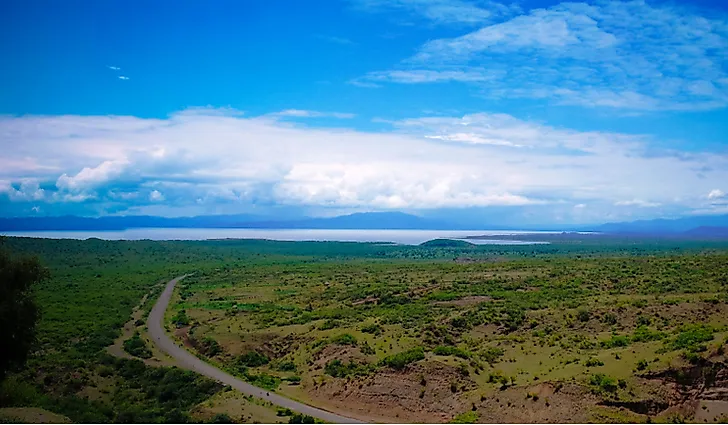Major Lakes Of The Ethiopian Rift Valley

The lakes of the Ethiopian Rift Valley, which is part of the larger East African Rift, are the northernmost lakes of the African Rift Valley and include some of the world's oldest, deepest, and largest lakes. The Ethiopian Rift Valley, also referred to as the Great Rift Valley of Ethiopia, is situated between the Ethiopian Highlands, in the central part of the country. The lakes within the Ethiopian Rift Valley support great biodiversity and are of significant importance to the Ethiopian economy. Some of the major lakes of the Ethiopian Rift Valley are highlighted below.
7. Lake Awasa
Located south of Addis Ababa in the Main Ethiopian Rift, Lake Awasa covers an area of 129 km2. Additionally, the lake is 16 km long, has a maximum width of 9 km and a maximum depth of 10 m, and is situated at an elevation of 1,708 m above sea level. Lake Awasa is easily accessible and has therefore become the most studied lake of the Ethiopian Rift Valley Lake system by scientists. Despite having an endorheic basin, Lake Awasa is a freshwater lake, which means it has a subterranean outlet.
6. Lake Abijatta
Located within Abijatta-Shalla National Park and south of Addis Ababa, Lake Abijatta is an alkaline lake with a surface area of 205 km2. The lake has a maximum length of 17 km, a maximum width of 15 km, a maximum depth of 14 m, and is situated at an elevation of 1,573 m. The northeastern corner of Lake Abijatta contains several hot springs that are popular among tourists. Reserves of soda ash are mined on the shores of the lake. Additionally, Lake Abijatta is also an important flamingo habitat.
5. Lake Langano
Located in the Oromia Region of Ethiopia, about 200 km south of Addis Ababa, Lake Langano is a covers an area of 230 km2. The lake is 18 km long, has a width of 16 km at its widest point, reaches a maximum depth of 46 m, and is situated at an elevation of 1,585 m above sea level. Lake Langano is a freshwater lake but its water appears brown. Although its color can give the impression that the lake is polluted, it is one of the cleanest lakes in the region and its brown water is the result of high mineral content. The area surrounding the lake is forested and rich in wildlife, and also contains numerous resorts.
4. Lake Shala
Lake Shala is located within Abijatta-Shalla National Park and occupies an area of 329 km2. The lake is 28 km long, has a width of 12 km at its widest point, and is situated at an elevation of 1,558 m above sea level. Additionally, Lake Shala is the deepest lake in the Ethiopian Rift Valley, with a maximum depth of 266 m. The lake is surrounded by numerous hot springs and the lake bed contains sulfur springs. Steam rising from the boiling water of the hot springs creates fog around the lake. Lake Shala also serves as a habitat for several species of birds including great white pelicans and flamingos.
3. Lake Zway
Lake Zway is a freshwater lake located approximately 100 miles south of Addis Ababa, where it occupies an area of 440 km2. The lake has a maximum length and width of 31 km and 20 km, respectively, a maximum depth of 8.9 m, and is situated at an elevation of 1,636 m above sea level. Lake Zway contains several islands, including Tulu Gudo, which features an ancient monastery. The lake and its surrounding area support a significant population of birds and hippopotamuses. Approximately 2,454 tonnes of fish are caught from the lake's waters each year, serving as an important source of income for the local population. The islands and shores of Lake Zway are inhabited by the Zay people. Additionally, the town of Zway is located one the western shore of the lake.
2. Lake Chamo
Lake Chamo is located in the Southern Nations, Nationalities, and Peoples' Region (SNNPR) of southern Ethiopia and occupies an area of 317 km2. The lake has a maximum length and width of 32 km and 13 km, respectively, reaches a maximum depth of 14 m, and is situated at an elevation of 1,110 m above sea level. Lake Chamo is primarily fed by the Kulfo River and the overflow from Lake Abaya. The lake is inhabited by marine wildlife such as the Nile crocodile, hippopotamus, Nile perch, and catfish.
1. Lake Abaya
Lake Abaya is located near Lake Chamo, east of the Guge Mountains in the Main Ethiopian Rift. The lake encompasses an area of 1,162 km2 and has a maximum length and width of 60 km and 20 km, respectively. Additionally, the lake has a maximum depth of 13.1 m and is situated at an elevation of 1,175 m above sea level. Lake Abaya has three primary inflows, which are the Bilate River, Gidabo River, and Gelana River. The lake and its surrounding savanna support various birdlife and wildlife, and also serves as an important fishing area for the local populatiuon.











